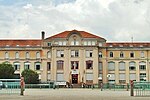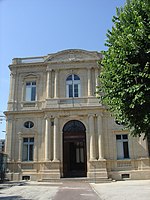Protestant Cemetery, Bordeaux
Anglican cemeteries in EuropeCemeteries established in the 1820sCemeteries in FranceHuguenot cemeteriesLutheran cemeteries ... and 2 more
Protestant Reformed cemeteriesProtestantism in France

The Protestant cemetery of Bordeaux (French: Le cimetière protestant de Bordeaux) is a historic, church-owned and operated Protestant cemetery located in the city of Bordeaux, in France. The cemetery was inaugurated in 1826 in the district of Caudéran. And the first burial was recorded in March 1827. Enlarged in 1867, a small funerary chapel was built in 1910 on the cemetery ground.
Excerpt from the Wikipedia article Protestant Cemetery, Bordeaux (License: CC BY-SA 3.0, Authors, Images).Protestant Cemetery, Bordeaux
Rue Judaïque, Bordeaux Saint-Bruno
Geographical coordinates (GPS) Address Nearby Places Show on map
Geographical coordinates (GPS)
| Latitude | Longitude |
|---|---|
| N 44.841 ° | E -0.5942 ° |
Address
Rue Judaïque 193
33000 Bordeaux, Saint-Bruno
Nouvelle-Aquitaine, France
Open on Google Maps








